The Tenor Banjo, a beloved and essential instrument in the vibrant Jazz Age and Dixieland music scene, is truly a musical gem. It stands out with its characteristic short neck and four strings, producing a distinct and captivating sound that resonates across various music genres and cultural landscapes. From the lively melodies of traditional Irish folk music to the energetic rhythms of early 20th-century American jazz, the Tenor Banjo has made its mark in the hearts of musicians and audiences alike.
With a rich history dating back to its origins, this remarkable instrument has played a significant role in shaping the soundscape of music. Its unique appeal continues to captivate and inspire musicians, allowing them to explore new sonic possibilities and create melodies that touch the soul. The Tenor Banjo is a testament to the power of music to transcend boundaries and bring people together in harmony.
What Is A Tenor Banjo?
A Tenor Banjo is a shorter-necked, four-stringed version of the traditional banjo. Known for its bright and sharp tonality, it is commonly tuned in fifths – similar to a viola or mandolin. The instrument initially gained popularity in jazz and Dixieland bands of the early 20th century, but its versatile sound has enabled it to permeate various genres, including traditional Irish music. With its crisp sound and distinctive play style, the Tenor Banjo offers a unique blend of rhythmic and melodic capabilities that continues to charm musicians and listeners to this day.[1]

Types Of Tenor Banjo
There are primarily two types of tenor banjos: the 17-fret and the 19-fret. The 17-fret tenor banjo, with its shorter scale length, is traditionally used in Irish traditional music. Its design allows for quick fingering and a brighter sound, ideal for fast-playing jigs and reels. On the other hand, the 19-fret tenor banjo, having a longer neck, is more commonly found in jazz music. The extra frets provide a deeper, richer tone and more note range, lending itself to the improvisational nature of jazz. Despite these differences, both types retain the signature sharp and rhythmic sound of the tenor banjo.[1]
What Is A 5 String Banjo?
The 5 string banjo, such as the Tenor Banjo, holds a significant place within the banjo family, offering a distinctive set of characteristics that define its unique charm. Notably, it features a fifth drone string that originates from the fifth fret, contributing to its distinctively twangy sound. This additional string is conventionally tuned to a high “G,” setting the 5 string banjo apart from other stringed instruments and greatly influencing its playing style. Its pivotal role extends across various music genres, with bluegrass music being particularly noteworthy for showcasing its bright, lively sound that adds depth and complexity to compositions. Nevertheless, the versatility of the 5 string banjo allows it to transcend genres, enhancing the musical landscapes of folk, country, and even rock genres. As a result, it’s no surprise that the 5 string banjo has become a cherished instrument among musicians of diverse backgrounds and preferences.[1]

The Different Styles of Playing the Tenor Banjo
When it comes to the Tenor Banjo, a variety of playing styles can be employed, each offering its own unique sound and feel. The two most common techniques include picking and strumming. Picking involves playing individual notes with a plectrum, resulting in a crisp and clear sound. This style is often associated with jazz and Dixieland music, allowing for intricate solos and improvisations. Strumming, on the other hand, involves brushing the plectrum across multiple strings at once, producing a fuller, richer sound. This method is often used in traditional Irish music, enhancing the rhythmic qualities of jigs and reels.
Furthermore, the Tenor Banjo’s unique construction contributes to its vibrant tonality and rhythmic capabilities. With its shorter scale length and steel strings, the instrument produces a bright and punchy sound, perfect for cutting through the mix in ensemble settings. The resonant body and tight head tension further enhance the instrument’s projection and sustain, ensuring that every note rings out with clarity and definition.
With its rich history and diverse range of playing styles, the Tenor Banjo continues to captivate musicians and audiences alike. Whether you’re strumming lively Irish tunes, picking out intricate jazz melodies, or fingerpicking delicate folk arrangements, the Tenor Banjo offers a world of expressive possibilities.[2]
Who is Known for Playing the Tenor Banjo?
Several talented musicians have made a significant mark in music history by mastering the Tenor Banjo, leaving behind a rich and enduring legacy that spans across various genres. One such iconic figure is Eddie Peabody, affectionately known as the “King of the Banjo.” This renowned American banjo player mesmerized audiences with his exceptional skills and captivating performances, particularly in the realms of Dixieland jazz and popular music during the early to mid-20th century. Peabody’s virtuosity and engaging style propelled the tenor banjo into the spotlight, earning him well-deserved international acclaim.
In the realm of traditional Irish music, the indelible impact of Barney McKenna cannot be overstated. McKenna, a member of the esteemed Irish band The Dubliners, showcased his remarkable fingerwork and brisk strumming style on the tenor banjo, infusing the band’s sound with a vibrant and rhythmic element. His contributions significantly influenced the role of the tenor banjo in Irish folk music, cementing his place as a true legend in the genre.
Additionally, it is worth mentioning the innovative work of Munde, who, although primarily recognized for his expertise on the five-string banjo, also made significant contributions to the tenor banjo. Munde’s groundbreaking techniques elevated the instrument’s versatility and expanded its reach, leaving a lasting impact on its evolution. With these influential figures and many more, the Tenor Banjo continues to emanate its vibrant sound, resonating across a multitude of music genres.[2]

How Much Do Tenor Banjos Usually Cost?
The cost of a Tenor Banjo can vary widely based on several factors, including the brand, the materials used, the craftsmanship, and whether the instrument is new or used. Entry-level tenor banjos, ideal for beginners or those on a budget, can range from around $200 to $500. These instruments provide a decent sound and are perfect for learning how to play.
Moving up the ladder, intermediate tenor banjos offer a better quality of sound and build. With a price range of $500 to $1,000, these banjos are crafted with enhanced attention to detail and provide a more refined playing experience. They are a great choice for those who have developed their skills and want to upgrade their instrument.
For those seeking professional-grade tenor banjos, the options become even more exciting. These high-end banjos are often hand-crafted with superior materials and exquisite detailing. Prices for professional-grade banjos can start from $1,000 and go up to several thousand dollars. The meticulous craftsmanship and superior tonal qualities of these instruments make them a favorite among seasoned musicians.
It’s important to note that the price of the instrument does not always reflect its potential. A less expensive banjo, when in the hands of a dedicated and passionate musician, can produce a sound just as beautiful as a high-end model. Always consider your budget, playing level, and needs when choosing a tenor banjo. With careful selection, you can find a banjo that suits your style and allows you to create beautiful music for years to come.[2]

FAQ
Is a 4 string banjo a tenor?
Yes, a 4 string banjo is typically referred to as a Tenor Banjo. However, there are two types of 4 string banjos: Tenor and Plectrum.
The Tenor Banjo, as discussed earlier, comes in 17-fret and 19-fret variants, and is popularly used in Irish traditional and jazz music. With its shorter scale length, the Tenor Banjo produces a bright and crisp sound that adds a lively touch to the music. Its versatility allows musicians to explore various musical genres, making it a beloved instrument among performers and enthusiasts alike.
On the other hand, Plectrum Banjos have a longer scale length compared to the Tenor Banjo. This difference in scale length gives the Plectrum Banjo a unique tonal quality, making it a preferred choice in traditional jazz and Dixieland music. The Plectrum Banjo’s rich and resonant sound adds depth and complexity to the music, providing a melodic backdrop for other instruments.
Despite their differences, both types of 4 string banjos share common characteristics such as their crisp, bright sound, and versatility in various musical genres. Whether it’s the lively melodies of Irish traditional music or the energetic rhythms of jazz and Dixieland, these banjos are cherished for their ability to captivate and inspire musicians and audiences alike.
Can you use a 5 string banjo as a tenor banjo?
Technically, a 5 string banjo cannot be used as a tenor banjo due to their structural and sound differences. The tenor banjo, commonly a 4 string instrument, has a shorter neck and is tuned differently from its 5 string counterpart. The 5 string banjo’s defining characteristic is the presence of a fifth drone string, which starts from the fifth fret and gives it its unique sound. This additional string not only adds depth to the banjo’s tone but also enables players to create intricate melodic patterns. In contrast, the tenor banjo’s four strings are tuned in fifths, allowing for a more straightforward playing style that complements its use in various music genres.
While it is technically possible to tune a 5 string banjo to match a tenor banjo’s tuning, the structural differences and scale length would still distinguish them. The tenor banjo’s shorter neck and tighter string tension contribute to its distinctive sound, which is further complemented by its tuning. Additionally, each instrument has its own nuances and performance techniques that are specific to their respective music genres. The 5 string banjo is often associated with bluegrass and folk music, while the tenor banjo finds its place in jazz and traditional Irish music.
Therefore, while the 5 string banjo and tenor banjo share common features as members of the banjo family, they are not typically interchangeable due to their unique characteristics and intended musical applications.

What is an Irish tenor banjo?
The Irish Tenor Banjo, a cherished variant of the traditional tenor banjo, holds a significant and illustrious place in the rich tapestry of Irish traditional music. With its distinct tuning and captivating role, it continues to captivate the hearts and souls of musicians and enthusiasts alike, drawing them into the timeless allure of this enchanting instrument.
This delightful 4-stringed instrument is commonly tuned to GDAE, mirroring the tuning of a violin or mandolin. This shared tuning not only fosters a sense of familiarity for musicians who are well-versed in these instruments but also opens up a world of melodic possibilities, allowing for the creation of intricate and mesmerizing melodies that resonate with the essence of Irish music. The Irish Tenor Banjo’s unique tuning, set higher than the standard tenor banjo tuning, grants it a vibrant and animated sound that is instantly recognizable and utterly captivating. Its bright timbre and lively resonance dance through the air, infusing the spirited rhythms of Irish jigs and reels with an extra layer of energy and liveliness, creating an atmosphere that is electric and invigorating.
The Irish Tenor Banjo owes much of its enduring popularity in Irish music to the legendary musicians who have embraced it as their instrument of choice. Icons such as Barney McKenna of The Dubliners have wielded this instrument with virtuosic skill, showcasing its remarkable ability to both carry the melody and drive the rhythm, solidifying its place in the hearts of musicians and listeners alike. The nimble fingers of these masters effortlessly glide across the strings, painting a vivid musical landscape that echoes with the spirit of Ireland’s musical heritage.
Even in the present day, the Irish Tenor Banjo stands as an integral part of the vibrant sessions and awe-inspiring performances of Irish traditional music across the globe. Its unmistakable presence adds a touch of authenticity and tradition to every note played, creating a captivating atmosphere that transports listeners to the very heart and soul of Irish musical heritage. As its melodies intertwine with other instruments, a sense of unity and connection is forged, embodying the communal spirit that lies at the core of Irish music.
Thus, the Irish Tenor Banjo, with its rich history, evocative sound, and enduring allure, continues to weave its spell, enchanting all who have the privilege to listen and partake in its harmonious journey through the ages.
What key is the tenor banjo?
The tenor banjo, a highly versatile instrument, offers a myriad of tuning options to cater to diverse playing styles and musical preferences. For instance, the standard tuning for a 19-fret tenor banjo is C-G-D-A, which is somewhat similar to the viola. This particular tuning is commonly utilized in traditional jazz and certain folk music genres, allowing musicians to create captivating melodies and harmonies. On the other hand, the 17-fret tenor banjo, often associated with Irish traditional music, is typically tuned to G-D-A-E, resembling the tuning of a violin or mandolin. This alternate tuning not only expands the tonal possibilities but also contributes to the vibrant and spirited sound that is characteristic of Irish music.
However, it’s worth noting that these tunings are only the beginning. The tenor banjo’s tuning can be further adjusted to suit the specific needs of the musician and the musical demands they encounter. This adaptability is what makes the tenor banjo a beloved instrument among musicians, enabling them to explore an incredibly vast array of tones, styles, and musical expressions. Whether it’s the rich and soulful melodies of jazz, the energetic and foot-tapping rhythms of Irish jigs, or any other genre, the tenor banjo is always ready to take on the challenge and create beautiful music that resonates with both the player and the audience.
In conclusion, the tenor banjo is not just a mere instrument; it is a gateway to a world of musical exploration and self-expression. Musicians of all backgrounds and genres can find solace and inspiration in the tenor banjo’s ability to adapt, evolve, and create unique sounds that resonate with their inner artistic vision. So, whether you’re a seasoned musician or just starting your musical journey, the tenor banjo awaits, ready to accompany you on a captivating and fulfilling musical odyssey.

What’s the difference between a banjo and a tenor banjo?
The term “banjo” is often used as a broad term that encompasses a number of different types of banjos, including the tenor banjo. However, there are key differences between a traditional banjo and a tenor banjo. The most apparent difference lies in the number of strings and the tuning. A traditional banjo, often a 5-string banjo, has a unique drone string that starts from the fifth fret, giving it its distinctive twangy sound. It’s often tuned to open G tuning, which is G-D-G-B-D, from the fifth to the first string.
On the other hand, a tenor banjo has only four strings and lacks a drone string, resulting in a different sound and playing style. Its typical tunings are C-G-D-A for the 19-fret tenor banjo and G-D-A-E for the 17-fret variant, used commonly in Irish music. The shorter neck of the tenor banjo also makes it easier to play for those with smaller hands or those transitioning from smaller stringed instruments, like the violin or the mandolin.
In addition to the differences in strings and tuning, the playing techniques and musical genres associated with each banjo type also vary. The 5-string banjo is prominently linked to bluegrass and country music, with its distinct sound adding a lively twang to these genres. On the other hand, the tenor banjo is widely used in jazz, Dixieland, and Irish traditional music, where its unique timbre and versatile playing style contribute to the characteristic melodies and rhythms of these genres.
By understanding these differences and nuances, musicians can explore the rich possibilities offered by various banjo types and choose the one that best suits their musical preferences and playing style. Whether it’s the vibrant energy of bluegrass or the soulful improvisations of jazz, the banjo remains a versatile and cherished instrument in the realm of music.
Useful Video: How to Play the Irish Tenor Banjo : Banjo Basics
Conclusion
In conclusion, the tenor banjo, with its four-string configuration and distinctive tunings, holds a unique and fascinating place in the world of string instruments. Its versatility and adaptability make it a sought-after choice for musicians across various genres.
The traditional Tenor Banjo, known for its bright and vibrant sound, has been a staple in traditional Irish music for decades. Its melodic qualities and rhythmic capabilities make it an essential component of Irish session bands and folk ensembles.
On the other hand, the Irish Tenor Banjo, with its shorter scale length and higher tuning, offers a unique tone that perfectly complements the fast-paced and intricate melodies of Irish jigs and reels. It has gained popularity among traditional Irish musicians and has become synonymous with the distinctive sound of Irish music.
In addition to these two variations, we have the Plectrum Banjo, which features a long neck and is typically played with a plectrum or pick. This style of banjo is commonly used in jazz and ragtime music, providing a rich and resonant sound that adds depth and complexity to the music.
While there are noticeable differences between a tenor banjo and its 5-string cousin, both instruments contribute to the rich tapestry of music with their unique sounds and playing styles. Choosing between them depends on the musical style you wish to pursue, your budget, and personal preference.
So, whether you’re drawn to the lively rhythms of Irish traditional music, the soulful melodies of jazz, or the timeless charm of folk music, the tenor banjo offers a world of possibilities. Embrace the journey of discovering the joy and rich history that comes with playing this remarkable instrument, and let its captivating sound inspire your musical endeavors.
References:
- https://www.banjo.ie/tenor-banjo-versus-5-string-banjo/
- https://blog.mcneelamusic.com/understanding-tenor-banjos-origins-its-evolution/










Leave a Reply